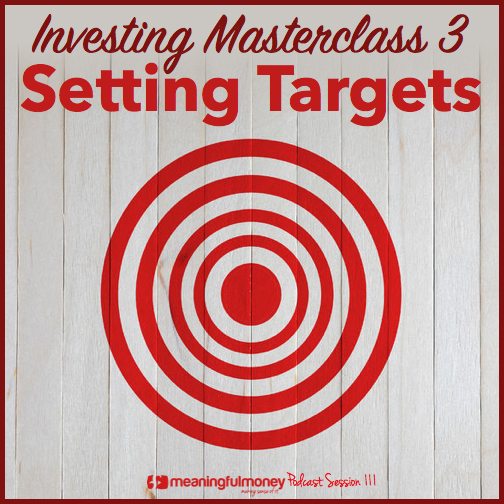
We’re continuing our Investment Masterclass today, having taken a bit of a break for the past six weeks or so. Although, you could argue that my interview with Greg Davies of Barclay about behavioural finance was timely. Today we’re going to talk about setting targets, and perhaps more importantly, to achieve them. Stay tuned…
Podcast: Subscribe in iTunes | Play in new window | Download
**PS, apologies for the sub-optimal audio quality this week. As you'll hear on the show, I was recording in a hotel room…!**
If this show is of any use to you, it would help me massively if you would take the time to leave me a review on iTunes. This has a huge impact on keeping me near the top of the rankings, which in turns helps more people to find the show and to subscribe. I’ll remind you again at the end of the show, but if you want to do it right now, just click the button below:
Sponsor Message
 This podcast is brought to you with the help of Seven Investment Management, a firm of investment managers based in London. They specialise in multi-asset investing, bringing institutional investing techniques to ordinary people like you and me. 7IM put their name to my show and to my site because they believe in what I’m doing, trying to get decent, easy-to-understand financial information out to the world. I’m very grateful to them for their support.
This podcast is brought to you with the help of Seven Investment Management, a firm of investment managers based in London. They specialise in multi-asset investing, bringing institutional investing techniques to ordinary people like you and me. 7IM put their name to my show and to my site because they believe in what I’m doing, trying to get decent, easy-to-understand financial information out to the world. I’m very grateful to them for their support.
You can see what they’re up to at 7im.co.uk
Introduction
So far in this series we have looked at Asset Allocation and Risk. We need now to set our sights in the distance and look at setting useful targets.
Everything you need to KNOW
1 – Having a target helps you stay the distance
There are a million metaphors for this, but how about the one of a runner racing towards to the tape. They know where they are heading, and glory awaits.
It’s the same reason they put the trophy on the snooker table before the final of the world championships (congrats to Stuart Bingham, by the way). The players can see what they’re aiming at, and a fat cheque awaits. And some glory as well, obviously.
Same with your financial targets. Because they tend to be quite a long way in the distance, it really, REALLY helps to have them visible as you go along.
Not just about motivation though, it’s basic maths. In order to get from A to B, you need to know where A is (where you are now), where B is (where you want to get to) and what the route is from A to B. More on this in a bit.
2 – Long term targets are achieved in small chunks
How do you eat an elephant? In small pieces.
Not only are most financial targets some way off in the distance, they’re also pretty large. Pay off the £100,000 mortgage by 2020. Save £15,000 for my daughter’s wedding by 2025. Save up £10,000 for a new car in three years’ time.
These are big numbers, but if you convert them into monthly savings chunks, as we will in a minute, then they can seem a bit more manageable.
3 – Targets should be MT. No, not Empty. M-T
Anyone who has spent time in management meetings or strategy sessions will have heard of SMART goals. SMART is an acronym, which defines what a good target or goal should be
S – specific, M – measurable, A – Achievable, R – Relevant, T – time-bound
I get it, but I think three of those aren’t really needed here. Instead let’s call them MT Targets. That means your targets should have two parameters;
M – Measurable. In other words, put a pound, dollar, euro or yen figure on it.
T – Time-bound. In other words, put a deadline on it.
With these, you have everything you need to create workable targets, which you can then work back from to come up with the amount you’re going to have to save THIS MONTH if you’re going to have any chance of hitting your target.
Let’s look at how to do that now.
Everything you need to DO
1 – Define a target
Let’s consider an MT target we can work towards. Let’s make it a big one. Let’s say you’re 30 now and you would like to have an amount roughly equal to £250,000 when you’re 60.
Our M and T are in place:
Measurable – has a numerical value £250,000
Time-bound – by the time we’re 65.
That’s a long term goal!! But it is defined, that’s the point.
How do we know what we have to put away now to hit our target? That depends on some things…
2 – Make assumptions
Two main assumptions you need to make:
Inflation
Inflation: 3%
Growth:
Cautious: 4.5-5%
Balanced: 5.5-6%
Growth: 7-7.5%
For a quick fix – take one off the other, so take inflation off growth.
3 – Break it down and take it one month at a time
In order to work out an amount per month you need to invest, you’ll need to use a compounding calculator
Here’s one: meaningfulmoney.tv/calculator
You might have to experiment with monthly amounts to get to your target. But look at the difference it makes when you increase your contribution with inflation.
35 years, £250pm, 4.5% return
– Non-indexed payment: £255,389
– Indexed payment: £386,237
4 – Pay yourself first
Once you know what you’re going to have to put away each month, set things up to pay yourself first.
Don’t think you’ll save it ‘if’ you have anything left at the end of the month, because you probably never will. Or not consistently anyway.
Parkinson’s Law – work expands to fill the time available. Finance version: expenditure rises to meet income.
Set up a standing order from the account into which you are paid, for the day after you are paid. Simple as.
5 – Review progress regularly
This is good sense anyway – but when working towards a target it’s essential.
If you re-run the calculations without taking inflation into account, you can have an idea about where you should be at the end of each year. Track progress against this.
Money doesn’t work in straight lines. Understand that investments have good years and bad years, but if it’s a long term plan, then it should even out over time.
Why might you make changes?
– Personal circumstances
– Legislative changes
Generally NOT due to markets. Markets will do what they always do. Hang in there for the long haul and you should be fine.
Summary
Targets need to be attractive enough to keep your interest and measurable so you can track performance.
The maths behind setting the target isn’t difficult, it’s dreaming big enough in the first place!
Don’t forget, a full transcript of this entire episode is available if you hit the button below:
Resources
Compounding calculator: meaningfulmoney.tv/calculator
Reviews
Big thanks to AlanKphysio for his review this week.
Don’t forget to go to meaningfulmoney.tv/iTunes or hit the big red button below to leave a review – it really helps!
Next Session Announcement
Next time I’ll be continuing the Investment Masterclass, and talking about Understanding Costs.
If you have any financial query that you want answering here on the show, then the best way to do that is to leave me a voicemail at meaningfulmoney.tv/askpete





Leave a Reply